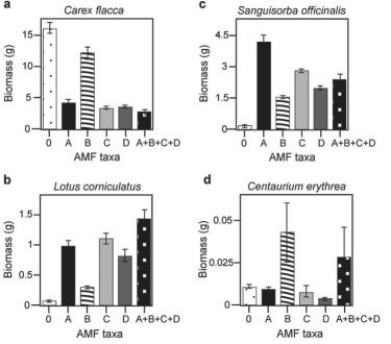Use the following information to answer the question.
Suzanne Simard and colleagues knew that the same mycorrhizal fungal species could colonize multiple types of trees. They wondered if the same fungal individual would colonize different trees, forming an underground network that potentially could transport carbon and nutrients from one tree to another (S. Simard et al. 1997. Net transfer of carbon between mycorrhizal tree species in the field. Nature 388:579-82) .
Pots containing seedlings of three different tree species were set up and grown under natural conditions for three years (Fig. A) . Two of the three species (Douglas fir, birch) could form ectomycorrhizal connections with the same fungal species, but the third species (cedar) could not form an ectomycorrhizal connection with the fungal species. In some of the pots, the researchers placed airtight bags over the Douglas fir and birch seedlings and injected carbon dioxide made from carbon-13 into the bags with the Douglas fir and carbon dioxide made from carbon-14 into the bags with the birch. (13C and 14C are different isotopes of carbon that can be detected and measured by researchers.) As the seedlings photosynthesized, the carbon dioxide was converted into sugars that could be tracked and measured by the researchers. The researchers measured whether the sugars in each plant contained only the carbon isotope that was in the air of their plastic bag or also the carbon isotope from the air around the other plant.
Simard et al. (1997) further hypothesized that if reciprocal transfer did occur, it would be a source-sink relationship driven by photosynthetic rates. That is, if one seedling is in full sun and the other in deep shade, there will be a net movement of carbon from the seedling in full sun to the one in deep shade. If a shade were placed over the birch seedlings and the cedar, and the Douglas fir was left in full sun, what result could Simard and colleagues expect?
Definitions:
HisA Enzyme
An enzyme involved in the biosynthesis pathway of histidine, an essential amino acid, playing a critical role in microbial metabolism.
Atmospheric Oxygen
The volume of oxygen gas present in the Earth's atmosphere, essential for the respiratory processes of most living organisms.
Gigantic Insects
Refers to unusually large insects, often depicted in science fiction and fantasy, not currently existing due to physical and environmental limitations.
Detoured Nerve
A nerve that has been rerouted from its usual path, often as a result of injury or during a surgical procedure, affecting impulse transmission.
Q4: If you were asked to design a
Q21: Which taxon is essentially equivalent to the
Q25: Use the figure to answer the question.<br>A:
Q33: Use the following information to answer the
Q36: Plant species A has a diploid number
Q40: Why is nitrogen fixation an essential process?<br>A)
Q44: How would you expect the root system
Q54: A narrow hybrid zone separates the toad
Q56: Use the following description and table
Q68: Use the following information to answer the